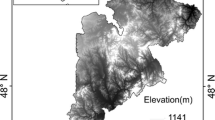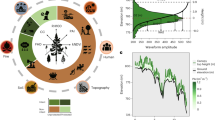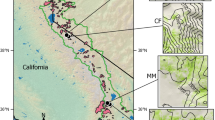Abstract
Vegetation pattern on landscapes is the manifestation of physical gradients, biotic response to these gradients, and disturbances. Here we focus on the physical template as it governs the distribution of mixed-conifer forests in California's Sierra Nevada. We extended a forest simulation model to examine montane environmental gradients, emphasizing factors affecting the water balance in these summer-dry landscapes. The model simulates the soil moisture regime in terms of the interaction of water supply and demand: supply depends on precipitation and water storage, while evapotranspirational demand varies with solar radiation and temperature. The forest cover itself can affect the water balance via canopy interception and evapotranspiration. We simulated Sierran forests as slope facets, defined as gridded stands of homogeneous topographic exposure, and verified simulated gradient response against sample quadrats distributed across Sequoia National Park. We then performed a modified sensitivity analysis of abiotic factors governing the physical gradient. Importantly, the model's sensitivity to temperature, precipitation, and soil depth varies considerably over the physical template, particularly relative to elevation. The physical drivers of the water balance have characteristic spatial scales that differ by orders of magnitude. Across large spatial extents, temperature and precipitation as defined by elevation primarily govern the location of the mixed conifer zone. If the analysis is constrained to elevations within the mixed-conifer zone, local topography comes into play as it influences drainage. Soil depth varies considerably at all measured scales, and is especially dominant at fine (within-stand) scales. Physical site variables can influence soil moisture deficit either by affecting water supply or water demand; these effects have qualitatively different implications for forest response. These results have clear implications about purely inferential approaches to gradient analysis, and bear strongly on our ability to use correlative approaches in assessing the potential responses of montane forests to anthropogenic climatic change.
Similar content being viewed by others
References
Aber, J.D and Federer, C.A. 1992. A generalized, lumped-parameter model of photosynthesis, evapotranspiration, and net primary production in temperate and boreal forest ecosystems. Oecologia 92: 463–474.
Anderson, M.A., Graham, R.C., Alyanakian, G.J. and Martynn, D.Z. 1995. Late summer water status of soils and weathered bedrock in a Giant Sequoia grove. Soil Science 160: 415–422.
Arkley, R.J., 1981. Soil moisture use by mixed conifer forest in a summer-dry climate. Soil Sci Soc Am J 45: 423–427.
Beers, T.W, Press, P.E. and Wensel, L.C. 1966. Aspect transformation in site productivity research. J For 64: 691–692.
Bonan, G.B. 1989. A computer model of the solar radiation, soil moisture, and soil thermal regimes in boreal forests. Ecol Modelling 45: 275–306.
Bonan, G.B., and Sirois, L. 1992. Air temperature, tree growth, and the northern and southern range limits to Picea mariana. J Veg Sci 3: 495–506.
Botkin, D.B. 1993. Forest Dynamics: an Ecological Model. Oxford University Press, Oxford.
Botkin, D.B., Janak, J.F. and Wallis, J R. 1972. Some ecological consequences of a computer model of forest growth. J Ecol 60: 849–873.
Burns, R.M. and Honkala, B.H. (tech. coords.) 1990. Siluics of North America. Agric Handbook 654, USDA Forest Service, Washington, DC.
Clark, J., Silman, M., Kern, R., Macklin, E. and HilleRisLambers, J. 1999. Generalized seed dispersal near and far: patterns across temperate and tropical forests. Ecology 80: 1475–1494.
Cosby, B.J., Hornberger, G.M., Clapp R.B. and Ginn, T.R. 1984. A statistical analysis of the relationship of soil moisture characteristics to the physical properties of soils. Wat Res Res 20: 682–690.
Daly, C., Neilson, R.P. and Phillips, D.L. 1994. A digital topographic model for distributing precipitation over mountainous terrain. J Appl Meteor 33: 140–158.
Delcourt, H.R., Delcourt, P.A. and Webb, T. 1983. Dynamic plant ecology: the spectrum of vegetation change in space and time. Quat Sci Rev 1: 153–175.
Dingman, S.L. 1994. Physical Hydrology. Macmillan, New York.
Gardner, R.H., and Trabalka, J.R. 1985. Methods of uncertainty analysis for a global carbon dioxide model. Office of Energy Research, U.S. DOE, Washington, DC.
Graber, D.M., Haultain, S.A. and Fessenden, J.E. 1993. Conducting a biological survey: a case study from Sequoia and Kings Canyon National Parks. pp. 17–35. In Proceedings of the Fourth Conference on Research in California's National Parks. Edited by Veirs, S.D. Jr., Stohlgren, T.J. and Schonewald-Cox, C. U.S. Department of the Interior National Park Service Transactions and Proceedings Series 9.
Haefner, J.W 1996. Modeling biological systems: principle and applications. Chapman and Hall, New York.
Halpin, P.N. 1995. A cross-scale analysis of environmental gradients and forest pattern in the giant sequoia-mixed conifer forest of the Sierra Nevada. Ph.D. dissertation. University of Virginia, Charlottesville.
Harper, J.L. 1977. Population biology of plants. Academic Press, New York.
Helvey J.D. 1971. A summary of rainfall interception by certain conifers of North America. Pp. 103–113. In Proc. Third International. Symp. for Hydrology Professors, Biological Effects in the Hydrologic Cycle. Purdue Univ Agric Expt Station, West Lafayette.
Helvey, J.D. and Patric, J.H. 1965. Canopy and litter interception of rainfall by hardwoods of eastern United States. Water Res Res 1: 193–206.
Jarvis, P.G. and Leverenz, J.W. 1983. Productivity of temperate evergreen and deciduous forests. pp. 234–261. In Physiological Plant Ecology, vol. IV. Edited by Lange, O.L., Novel, P.S., Osmond, C.B. and Ziegler, H. Springer-Verlag, Berlin
Kozak, A., Munro, D.D. and Smith, J.H.G. Taper equations and their application in forest inventory. For Chron 45: 278–283.
Lassen, L.E. and Okkonen, E.A. 1969. Sapwood thickness of Douglas-fir and five other western softwoods. USDA For Serv Rep FPL-124. Forest Products Lab, Madison, WI.
Leemans, R. and Prentice, I.C. 1987. Description and simulation of tree-layer composition and size distribution in a primaeval Picea-Pinus forest. Vegetatio 69: 147–156.
Legendre, P. and Fortin, M.J. 1989. Spatial pattern and ecological analysis. Vegetatio 80: 107–138.
Loehle, C. and LeBlanc, D. 1996. Model-based assessments of climate change effects on forests: a critical review. Ecol Model 90: 1–31.
Miller, C. and Urban, D.L. 1999a. Fire, climate, and forest pattern in the Sierra Nevada, California. Ecol Model 114: 113–135.
Miller, C. and Urban, D.L. 1999b. Forest pattern, fire, and climatic change in the Sierra Nevada. Ecosystems 2: 76–87.
Miller, C. and Urban, D.L. 1999c. Interactions between forest heterogeneity and surface fire regimes in the southern Sierra Nevada. Canadian J For Res 29: 202–212.
Minore, D. 1979. Comparative autecological characteristics of Northwestern tree species-a literature review. USDA GTR PNW 87. PNW Forest and Range Expt Station, Portland.
Moore, I.D., Gryson, R.B. and Ladson, A.R. 1990. Digital terrain modelling: a review of hydrological, geomorphological, and biological applications. Hydrol Processes 5: 3–30.
Mueller, M.J. 1982. Selected climatic data for a global set of standard stations for vegetation science. Junk, the Hague.
Nikolov, N.T. and Zeller, K.F. 1992. A solar radiation algorithm for ecosystem dynamic models. Ecol Model 61: 149–168.
Parton, W.J., Schimel, D.S., Cole, C.V. and Ojima, D. 1987. Analysis of factors controlling soil organic levels of grasslands in the Great Plains. Soil Sci Soc Am J 51: 1173–1179.
Running, S.W and Coughlan, J.C. 1988. A general model of forest ecosystem processes for regional applications. I. Hydrological balance, canopy gas exchange, and primary production processes. Ecol Model 42: 125–154.
Running, S.W, Nemani, R.R. and Hungerford, R.D. 1987. Extrapolation of synoptic meteorological data in mountainous terrain and its use for simulating forest evapotranspiration and photosynthesis. Can J For Res 17: 472–483.
Sellers, W.D. 1965. Physical climatology. University Chicago Press, Chicago.
Shugart, H.H. 1984. A Theory of Forest Dynamics. Springer-Verlag, New York.
Shugart, H.H., Smith, T.M. and Post, W.M. 1992. The potential for application of individual-based simulation models or assessing effects of climate change. Ann Rev Ecol Syst 23: 15–38.
Smith, T.M. and Huston, M. 1989. A theory of the spatial and temporal dynamics of plant communities. Vegetatio 83: 49–69.
Smith, T.M., Shugart, H.H., Bonan, G.B. and Smith, J.B. 1992. Modeling the potential response of vegetation to global climate change. Adv Ecol Res 22: 93–116.
Solomon, A.M. 1986. Transient response of forests to CO2-induced climate change: simulation modeling experiments in eastern North America. Oecologia 68: 567–579.
Stephenson, N.L. 1988. Climatic control of vegetation distribution: the role of the water balance with examples from North America and Sequoia National Park, California. Ph.D. dissertation. Cornell University, Ithaca.
Stephenson, N.L 1990. Climatic control of vegetation distribution: the role of the water balance. Am Nat 135: 649–670.
Stephenson, N.L. 1998. Actual evapotranspiration and deficit: biologically meaningful correlates of vegetation distribution across spatial scales. J Biogeog 25: 855–870.
Stephenson, N.L. and Parsons, D.J. 1993. A research program for predicting the effects of climatic change on the Sierra Nevada. pp. 93–109. In Proceedings of the Fourth Conference on Research in California's National Parks. Edited by Veirs, S.D. Jr., Stohlgren, T.J. and Schonewal-Cox, C. U.S. Department of the Interior Park Service Transactions and Proceedings Series 9.
Urban, D.L. Demographic process and gradient response in forested landscapes (in prep.).
Urban, D.L., Acevedo, M.F. and Garman, S.L. 1999. Scaling fine-scale processes to large-scale patterns using models. pp. 70–98 In derived from models: meta-models. Spatial modeling of forest landscape change: approaches and applications. Edited by Mladenoff, D. and Baker, D. Cambridge University Press, Cambridge.
Urban, D.L., Bonan, G.B. and Shugart, H.H. 1991. Spatial applications of gap models. For Ecol Manag 42: 95–110.
Urban, D.L., Harmon, M.E. and Halpern, C.B. 1993. Potential response of Pacific Northwestern forests to climatic change: effects of stand age and initial composition. Climatic Change 23: 247–266.
Urban, D.L, O'Neill, R.V. and Shugart, 1987. Landscape ecology BioScience 37: 119–127.
Urban, D.L. and Shugart, H.H. 1992. Individual-based models of forest succession. pp 249–292 In Plant succession: theory and prediction. Edited by Glenn-Lewin, D.C., Peet, R.K. and Veblen, T.T. Chapman and Hall, London.
Vankat, J.L. 1982. A gradient perspective on the vegetation of Sequoia National Park, California. Madrono 29: 200–214.
VEMAP participants (J.M. Melillo and 26 others) 1995. Vegetation/ ecosystem modeling and analysis project (VEMAP): comparing biogeography and biogeochemistry models in a continental-scale study of terrestrial ecosystem responses to climate change and CO2 doubling. Global Biogeochemical Cycles 9: 407–437.
Waring, R.H. and Schlesinger, W.H. 1985. Forest Ecosystems: Concepts and Management. Academic Press, Orlando.
Waring, R.H., Schroeder, P.E. and Oren, R. 1982. Application of the pipe model theory to predict canopy leaf area. Can J For Res 12: 556–560.
Watt, A.S. 1947. Pattern and process in the plant community J Ecol 35: 1–22.
Weinstein, D.A. 1992. Use of simulation models evaluate the alteration of ecotones by global carbon dioxide increases. pp. 379–393. Landscape Boundaries: Consequences for Biotic Diversity and Ecological Flows. Edited by Hansen, A.J. and di Castri, F. Springer-Verlag, New York.
Whittaker, R.H. and Woodwell, G.M. 1967. Surface area relations of woody plants and forest communities. Am J Bot 54: 931–939.
Wiens, J.A. 1989. Spatial scaling in ecology. Functional Ecol. 8: 385–397.
Wolock, D.M. and McCabe, G.J. 1995. Comparison of single and multiple flow direction algorithms for computing topographic parameters in TOPMODEL. Water Resources Res 31: 1315–1324.
Yeakley, J.A., Swank, W.T., Swift, L.W., Hornberger, G.M. and Shugart, H.H. 1998. Soil moisture gradients and controls on a southern Appalachian hillslope from drought through recharge. Hydrol Earth Syst Sci 2: 41–49.
Ziemer, R.R. 1964. Summer evapotranspiration trends as related to time after logging of forests in Sierra Nevada. J Geophys Res 69: 615–620.
Zinke P.J. 1967. Forest interception studies in the United States. pp. 137–160. In Forest Hydrology. Edited by Sopper, W.E. and Lull, W. Pergamon, Oxford.
Author information
Authors and Affiliations
Rights and permissions
About this article
Cite this article
Urban, D.L., Miller, C., Halpin, P.N. et al. Forest gradient response in Sierran landscapes: the physical template. Landscape Ecology 15, 603–620 (2000). https://doi.org/10.1023/A:1008183331604
Issue Date:
DOI: https://doi.org/10.1023/A:1008183331604




